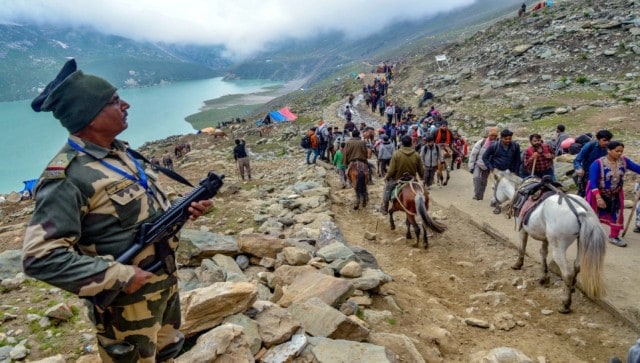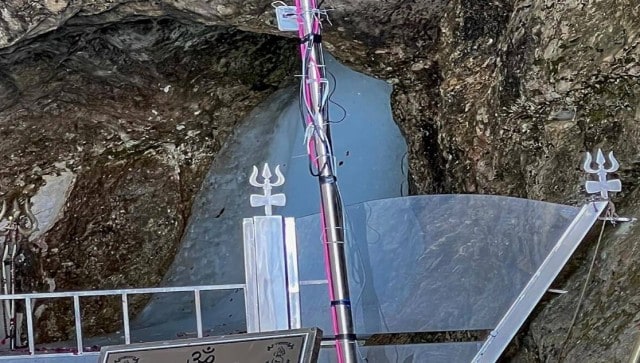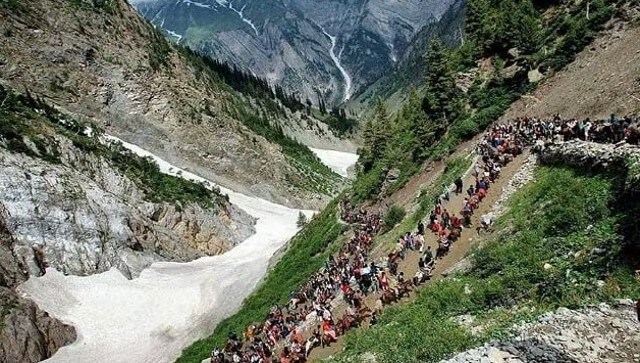Many pilgrims arrived at the Yatri Niwas Base Camp in Jammu on Thursday before the annual Amarnath Yatra starts on 1 July. Tomorrow, the first batch is likely to be formally greeted by Jammu and Kashmir’s lieutenant governor, Manoj Sinha. Hindus who travel to the Amarnath Cave, thought to be Lord Shiva’s dwelling, as part of the 62-day yatra, consider it to be a significant pilgrimage. However, this year’s yatra, which culminates on 31 August, is more noteworthy because it falls between two “Shravan” months, which hasn’t happened in 19 years. Amarnath Yatra 2023 would see the use of cutting-edge technology to secure the safety of the pilgrims, with the Srinagar Smart City’s Command Control Centre assuming its central position as the hub. Let’s look at the Yatra’s safety measures. Also read: Why ITBP and not CRPF are in charge of Amarnath Yatra security this year Advanced safety measures in place This time, the security system has undergone a significant overhaul with the Indo-Tibetan Border Police (ITBP) officers, who have received mountain warfare training, stationed at the cave shrine replacing the Central Reserve Police Force (CRPF). The CRPF, the country’s main internal security force, will still be stationed just beneath the cave shrine’s stairs while the ITBP and Border Security Force (BSF) keep an eye on the roughly half-dozen camps that were previously secured by them. In addition to adopting various security precautions, the Ministry of Home Affairs (MHA) has dispatched around 325 additional companies of the Central Armed Police Forces (CAPF) for their deployment along both routes of the Amarnath Yatra. According to Greater Kashmir, the expanded CAPF consists of 45 ITBP companies, 95 CRPF companies (including five Mahila companies), 90 BSF companies, 60 SSB companies, 35 CISF companies. [caption id=“attachment_12809142” align=“alignnone” width=“640”] The Ministry of Home Affairs (MHA) has dispatched around 325 additional companies of the Central Armed Police Forces (CAPF) for their deployment along both routes of the Amarnath Yatra. PTI/Representative Image[/caption] According to officials, more security personnel have been stationed along important road links and key roads to fend off any untoward acts. “Troop deployment has been finalised along highways and key junctions. Multiple checkpoints have been established along the Srinagar-Jammu national highway to monitor and track the movement of commuters. Stringent frisking procedures have been intensified at major spots along the highway,” an officer told Rising Kashmir. The official added that on all routes, pilgrim cars will have designated hours and will not be allowed to mix with other vehicles driven by civilians. The Yatra convoys would be escorted by paramilitary vehicles on both routes. The government has employed cutting-edge technology to ensure safety, security, weather forecasting, disaster management, traffic and logistics management, sanitation, and other services for the next Amarnath Yatra. In addition to utilising search and rescue dogs everywhere, particularly close to the cave shrine, sources told PTI that the use of drones was also emphasised in order to respond fast in the event of a natural or man-made disaster and secure the yatra routes. Along the Yatra route, sufficient Central paramilitary soldiers would be deployed. According to PTI sources, a team of National Disaster Response Force (NDRF) canines has already been dispatched to accustom the dogs to the high altitude and cold weather. In order to provide early warnings for any situation resembling a flash flood or a glacial lake outburst flood (GLOF), a team of experts and the NDRF will fly above the upper reaches. In order to reduce the number of fatalities from flash floods and glacial lake outburst floods (GLOF), the NDRF has been assigned to assist officials in choosing locations for the construction of pilgrim camps. Threats from terrorism will be defeated by three layers of security manned by the J&K police, CRPF, and Indian Army, as well as aerial surveillance, RFID tags for pilgrims, routine inspections of vehicles for IEDs, including sticky bombs, vehicle repair teams, and recovery teams. The BRO (Border Roads Organisation) has been given the task of preparing the tracks for the yatra, including repairing the bridges and weak or damaged railings, according to the Times of India. The government and police of Jammu and Kashmir also performed a mock drill in advance of the Amarnath Yatra, as per Rising Kashmir. The exercise, which was under the supervision of Mukesh Singh, Additional Director General of Police (ADGP), Jammu Zone, was designed to assess the yatris’ logistical needs and security measures. Also read: Amarnath Yatra: Poori, jalebi, burger banned; Check the list of food items allowed Other arrangements
Union Home Minister Amit Shah
sought enough oxygen cylinders, more medical teams, ambulances, and helicopters to ensure that pilgrims received proper medical care. Two 100-bed camp hospitals will be in operation in Jammu and Srinagar, according to the article. Each yatri will have a Rs 5 lakh insurance policy. Shah gave the order to make sure that Amarnath Yatris have access to all necessary services, including transportation, lodging, electricity, water, communication, and health care. [caption id=“attachment_12809132” align=“alignnone” width=“640”]
The Ministry of Home Affairs (MHA) has dispatched around 325 additional companies of the Central Armed Police Forces (CAPF) for their deployment along both routes of the Amarnath Yatra. PTI/Representative Image[/caption] According to officials, more security personnel have been stationed along important road links and key roads to fend off any untoward acts. “Troop deployment has been finalised along highways and key junctions. Multiple checkpoints have been established along the Srinagar-Jammu national highway to monitor and track the movement of commuters. Stringent frisking procedures have been intensified at major spots along the highway,” an officer told Rising Kashmir. The official added that on all routes, pilgrim cars will have designated hours and will not be allowed to mix with other vehicles driven by civilians. The Yatra convoys would be escorted by paramilitary vehicles on both routes. The government has employed cutting-edge technology to ensure safety, security, weather forecasting, disaster management, traffic and logistics management, sanitation, and other services for the next Amarnath Yatra. In addition to utilising search and rescue dogs everywhere, particularly close to the cave shrine, sources told PTI that the use of drones was also emphasised in order to respond fast in the event of a natural or man-made disaster and secure the yatra routes. Along the Yatra route, sufficient Central paramilitary soldiers would be deployed. According to PTI sources, a team of National Disaster Response Force (NDRF) canines has already been dispatched to accustom the dogs to the high altitude and cold weather. In order to provide early warnings for any situation resembling a flash flood or a glacial lake outburst flood (GLOF), a team of experts and the NDRF will fly above the upper reaches. In order to reduce the number of fatalities from flash floods and glacial lake outburst floods (GLOF), the NDRF has been assigned to assist officials in choosing locations for the construction of pilgrim camps. Threats from terrorism will be defeated by three layers of security manned by the J&K police, CRPF, and Indian Army, as well as aerial surveillance, RFID tags for pilgrims, routine inspections of vehicles for IEDs, including sticky bombs, vehicle repair teams, and recovery teams. The BRO (Border Roads Organisation) has been given the task of preparing the tracks for the yatra, including repairing the bridges and weak or damaged railings, according to the Times of India. The government and police of Jammu and Kashmir also performed a mock drill in advance of the Amarnath Yatra, as per Rising Kashmir. The exercise, which was under the supervision of Mukesh Singh, Additional Director General of Police (ADGP), Jammu Zone, was designed to assess the yatris’ logistical needs and security measures. Also read: Amarnath Yatra: Poori, jalebi, burger banned; Check the list of food items allowed Other arrangements
Union Home Minister Amit Shah
sought enough oxygen cylinders, more medical teams, ambulances, and helicopters to ensure that pilgrims received proper medical care. Two 100-bed camp hospitals will be in operation in Jammu and Srinagar, according to the article. Each yatri will have a Rs 5 lakh insurance policy. Shah gave the order to make sure that Amarnath Yatris have access to all necessary services, including transportation, lodging, electricity, water, communication, and health care. [caption id=“attachment_12809132” align=“alignnone” width=“640”] This year’s yatra, which culminates on 31 August, is more noteworthy because it falls between two “Shravan” months, which hasn’t happened in 19 years. PTI[/caption] Over 4,000 safai karamcharis would be hired, according to TOI, to maintain the cleanliness of the pilgrim facilities. Additionally, there will be a yatri feedback system. 92 per cent of pilgrims had given the arrangements a favourable rating as of 2022. Some deficiencies in traffic management that the pilgrims had identified had been fixed this year. The SASB offices in Srinagar and Jammu should be ready by the end of the year. Each of these facilities will be able to house 3,000 pilgrims. The ONGC CSR fund has contributed Rs 51 crore towards the construction of the Jammu facility. Tragedies at the holy shrine Due to its location, the Amarnath cave shrine in South Kashmir is susceptible to terrorist attacks. According to The Quint, due to threats of terrorist attacks, the annual yatra was forbidden from 1991 to 1993. In 1993, the Pakistan-based Harkat-ul-Ansar forbade yatras in opposition to the destruction of the Babri Masjid, as per The Indian Express. The yatra carried on unhindered during the turmoil since the local militant groupings did not endorse its demands. [caption id=“attachment_12809122” align=“alignnone” width=“640”]
This year’s yatra, which culminates on 31 August, is more noteworthy because it falls between two “Shravan” months, which hasn’t happened in 19 years. PTI[/caption] Over 4,000 safai karamcharis would be hired, according to TOI, to maintain the cleanliness of the pilgrim facilities. Additionally, there will be a yatri feedback system. 92 per cent of pilgrims had given the arrangements a favourable rating as of 2022. Some deficiencies in traffic management that the pilgrims had identified had been fixed this year. The SASB offices in Srinagar and Jammu should be ready by the end of the year. Each of these facilities will be able to house 3,000 pilgrims. The ONGC CSR fund has contributed Rs 51 crore towards the construction of the Jammu facility. Tragedies at the holy shrine Due to its location, the Amarnath cave shrine in South Kashmir is susceptible to terrorist attacks. According to The Quint, due to threats of terrorist attacks, the annual yatra was forbidden from 1991 to 1993. In 1993, the Pakistan-based Harkat-ul-Ansar forbade yatras in opposition to the destruction of the Babri Masjid, as per The Indian Express. The yatra carried on unhindered during the turmoil since the local militant groupings did not endorse its demands. [caption id=“attachment_12809122” align=“alignnone” width=“640”] Due to its location, the Amarnath cave shrine in South Kashmir is susceptible to terrorist attacks. PTI/Representative Image[/caption] In 2000, militants began targeting followers of Amarnath. According to Deccan Herald, 32 people were killed in the attack on the Pahalgam base camp, including 21 pilgrims. 13 people, including 2 police officers, were killed in a terrorist attack at Sheshnag Lake near the Amarnath Temple shrine in 2001, while another 15 people were left gravely injured. Eleven people died and at least 30 were injured in two separate attacks carried out in Pahalgam and Srinagar in 2002 by Al-Mansuriyan, the front group for Lashkar-e-Taiba. Another militant attack on a bus in Ganderbal, more than 23 miles from Srinagar, claimed the lives of five pilgrims from Rajasthan. In a terror attack on their bus in July 2017, seven pilgrims were killed. Days later, the government notified the Lok Sabha that 53 pilgrim deaths and 167 injuries have been caused by 36 terrorist attacks on the yearly Amarnath Yatra during the course of the 27 years since 1990. In addition to terrorist attacks, natural disasters have sometimes claimed the lives of pilgrims. As many as 242 people perished in the 1990s blizzards. According to Economic Times, 130 pilgrims died in 2012 because they were not physically prepared for the trek, while 250 pilgrims died in 1996 as a result of harsh blizzards and heavy snowfall. In 2022,
a cloud burst
at the foothill of the cave led to flash floods that killed several people. The deployment of one company there allowed ITBP jawans to be the first to arrive and save many lives. At least 16 people lost their lives nearby the shrine on July 8 of last year as a result of flash floods brought on by heavy rain. With inputs from agencies Read all the
Latest News
,
Trending News
,
Cricket News
,
Bollywood News
, India News
and
Entertainment News
here. Follow us on
Facebook
,
Twitter
and
Instagram
.
Due to its location, the Amarnath cave shrine in South Kashmir is susceptible to terrorist attacks. PTI/Representative Image[/caption] In 2000, militants began targeting followers of Amarnath. According to Deccan Herald, 32 people were killed in the attack on the Pahalgam base camp, including 21 pilgrims. 13 people, including 2 police officers, were killed in a terrorist attack at Sheshnag Lake near the Amarnath Temple shrine in 2001, while another 15 people were left gravely injured. Eleven people died and at least 30 were injured in two separate attacks carried out in Pahalgam and Srinagar in 2002 by Al-Mansuriyan, the front group for Lashkar-e-Taiba. Another militant attack on a bus in Ganderbal, more than 23 miles from Srinagar, claimed the lives of five pilgrims from Rajasthan. In a terror attack on their bus in July 2017, seven pilgrims were killed. Days later, the government notified the Lok Sabha that 53 pilgrim deaths and 167 injuries have been caused by 36 terrorist attacks on the yearly Amarnath Yatra during the course of the 27 years since 1990. In addition to terrorist attacks, natural disasters have sometimes claimed the lives of pilgrims. As many as 242 people perished in the 1990s blizzards. According to Economic Times, 130 pilgrims died in 2012 because they were not physically prepared for the trek, while 250 pilgrims died in 1996 as a result of harsh blizzards and heavy snowfall. In 2022,
a cloud burst
at the foothill of the cave led to flash floods that killed several people. The deployment of one company there allowed ITBP jawans to be the first to arrive and save many lives. At least 16 people lost their lives nearby the shrine on July 8 of last year as a result of flash floods brought on by heavy rain. With inputs from agencies Read all the
Latest News
,
Trending News
,
Cricket News
,
Bollywood News
, India News
and
Entertainment News
here. Follow us on
Facebook
,
Twitter
and
Instagram
.
Drones, dog squads and troops: How Centre is gearing up for Amarnath Yatra
FP Explainers
• June 30, 2023, 15:15:18 IST
This year’s Amarnath Yatra, starting from 1 July, will see the use of cutting-edge technology, such as aerial surveillance, drones, RFID tags for pilgrims, and routine inspections of vehicles. There will be three layers of security manned by the J&K police, ITBP, CRPF & more
Advertisement
)